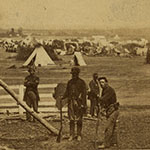
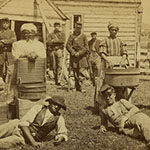
|
James F. Gibson. Brady’s Civil War Gallery. New York: E. & H. T. Anthony Gallery, 1862. Gift of Jesse G. Haydock.
Enslaved African Americans immediately viewed the Civil War as an opportunity for freedom. Barely a month after the first shots were fired in April 1861, three escaped slaves proclaimed their freedom by seeking refuge with the Union Army at Fort Monroe, Virginia. Over the course of the war, tens of thousands of these “contrabands of war” fled to the Union lines, often providing valuable intelligence about Confederate military actions or working in Union camps.
James F. Gibson, a photographer in Mathew Brady’s studio, photographed these contrabands in Virginia. |
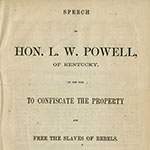 |
Lazarus W. Powell. Speech of Hon. L. W. Powell, of Kentucky, on the Bill to Confiscate the Property and Free the Slaves of Rebels. Washington, D.C.: L. Towers & Co., 1862.
On July 17, 1862, after months of fierce debate, Congress passed An Act to Suppress Insurrection, to Punish Treason and Rebellion, to Seize and Confiscate the Property of Rebels, and for Other Purposes, commonly known as the Second Confiscation Act. While the First Confiscation Act of 1861 allowed for the confiscation of property actively used to rebel against the Union, the 1862 act had wider-reaching consequences. In addition to establishing property confiscation as a punishment for treason, the law also decreed that slaves of rebels would be free and authorized the president to colonize freed people to “some tropical country beyond the limits of the United States.”
Many legislators, including Senator Powell, voted against the Act in the belief that Congress did not hold the constitutional authority to confiscate property without due process, even in times of war. Opponents also cited financial concerns stemming from the loss of revenue from taxed human property and the questionable economic feasibility of compensated emancipation and colonization of freed people. |
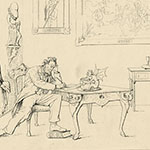 |
Adalbert Volck. Writing the Emancipation Proclamation. Tarrytown, N.Y.: W. Abbatt, 1863. Reprinted 1917.
Adalbert Volck, a Southern sympathizer and cartoonist, published a series of caricatures to represent the Confederate view of the war and abolition. Among them was this drawing, which called into question Lincoln’s legal and moral authority to issue the Emancipation Proclamation. Rife with symbolism, it depicts a deranged Lincoln sitting in a chair decorated with the head of an ass while the Constitution lies trampled under his foot and the devil holds his inkwell. |
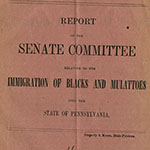 |
Pennsylvania General Assembly. Senate Committee on Negroes. Report of the Senate Committee Relative to the Immigration of Blacks and Mulattoes into the State of Pennsylvania. Harrisburg, Pa.: Singerly & Myers, State Printers, 1863.
Although the Union professed abolitionist sentiments after the Emancipation Proclamation, freed slaves were not always welcome in the North. A Pennsylvania State Senate committee issued this report in response to several petitions asking that the General Assembly stem the flow of freed people into the state. The committee recommended welcoming freed slaves, “for every slave we wrest from treason, we take one soldier.” |
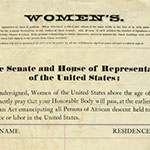 |
Women’s Loyal National League. [Petition]. New York, 1863.
Susan B. Anthony and Elizabeth Cady Stanton founded the Women’s Loyal National League in 1863 to support the Northern war effort and the abolition of slavery. Recognizing the limited scope of the Emancipation Proclamation, the League organized a massive petition campaign through its network of women’s rights advocates to persuade Congress to emancipate all slaves. By 1864, the group had collected 400,000 signatures using petitions such as this one. |
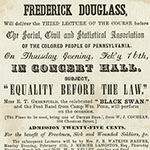 |
Social, Civil and Statistical Association of the Colored People of Pennsylvania. Equality Before the Law. Philadelphia, 1865.
Two years after the Emancipation Proclamation and a mere two weeks after Congress passed the Thirteenth Amendment to abolish slavery, African Americans were well aware that their battle to fight racism and to gain equal rights had not ended. William Still, a leader in Philadelphia’s Underground Railroad and chairman of the recently formed Social, Civil, and Statistical Association, organized a series of civil rights benefits which featured prominent African Americans, including Frederick Douglass, concert singer Elizabeth Greenfield, and author Frances Ellen Watkins Harper. |






